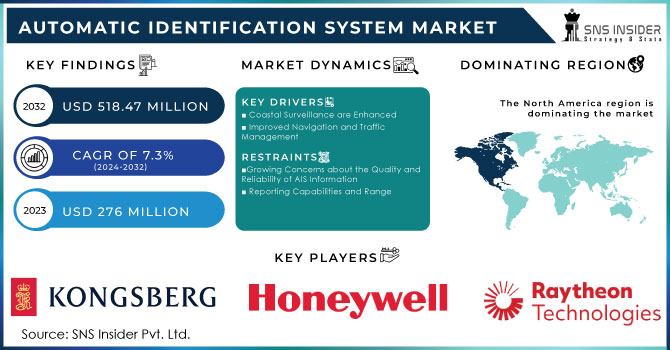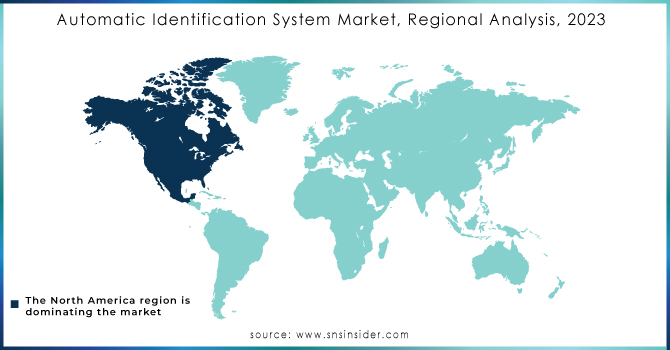Automatic Identification System (AIS) Market Report Scope & Overview:
The Automatic Identification System Market Size was valued at USD 276 million in 2023, expected to reach USD 518.47 million by 2032 with a growing CAGR of 7.3% over the forecast period 2024-2032.

To get more information on Automatic Identification System Market - Request Free Sample Report
The automatic detection system is an automated tracking system that uses transceivers on ships and is used by vessel traffic services to automatically track vessels to avoid any kind of collisions. It is designed to enable dual communication between different vessels and coastal authorities based on the coast. The system can provide static, dynamic, and cruise data about one vessel to other nearby vessels and nearby coastal authorities. In addition, AIS machines provide information such as different identities, course, speed, and on-screen location. These facilities are designed to assist the navigator by allowing maritime authorities to monitor and monitor the movement of ships. In addition, the existing transponder transmission system installed with these AISs is used to operate on a marine band operating at very high frequencies. This automated diagnostic system includes a standard VHF transceiver with a suspension system such as a GPS receiver and additional electronic navigation sensors that include a gyro-compass or rotation indicator. Moreover, because these systems are completely automated, they do not require human intervention, which is the main reason for widespread use. In addition, these systems are not affected by rain and can provide long wavelengths, which allows for better monitoring of the movement of vessels, especially at night.
MARKET DYNAMICS:
KEY DRIVERS
-
Coastal Surveillance are Enhanced
-
Improved Navigation and Traffic Management
RESTRAINTS
-
Growing Concerns about the Quality and Reliability of AIS Information
-
Reporting Capabilities and Range
CHALLENGES
-
Data Manipulation Practices by AIS
OPPORTUNITIES
-
Now casts Based on AIS for Real-Time Trade Activity
-
Government Involvement gets Increasing
THE IMPACT OF COVID-19
Local authorities have imposed restrictions on cargo ships and passengers to stop at ports due to the outbreak of the COVID-19 epidemic. Most of the merchant sailors were trapped inside the ship because of this. Shipowners were required to pay additional costs as their vessels were trapped in the water for extended periods. In addition, due to the outbreak, shipping was banned which resulted in a large number of seafarers reaching the conclusion of their employment contract and in need of renewal. In addition, in order to reduce the risk of the spread of COVID-19 there has been a reduction in the import and export of products and goods. In addition, all shipbuilding, ship repair & repair work has been suspended due to the epidemic. This has a direct impact on the market for automated diagnostic system. In addition, there has been a shortage of equipment needed to make hardware as there has been supply chain disruption and termination of cost control contracts. All of these factors have affected the market growth of automated diagnostic systems due to the COVID-19 epidemic.
The platform deployment of the automatic identification system varies depending on whether it is onshore, vessel-based, or satellite-based. Because of their high quantity and favourable regulatory mandate, vessel-based automatic identification systems are likely to dominate the global market.
The automatic identification system is classified into three types: Class A, Class B, and Class C, which are both transponders, and Class C, which is an automatic identification system receiver. The automatic identification system is primarily used in the marine industry for collision avoidance, fishery monitoring and control, vessel traffic services, maritime security, ocean race management, navigation, search and rescue, environment rescue, fleet and cargo tracking, and accident investigation. The government has created necessary regulations for the implementation of AIS in order to improve ship safety and security. In 2000, the International Maritime Organization (IMO) mandated that all ships carry AIS capable of automatically communicating information about the ship to other ships and coastal authorities. The regulation mandates the installation of AIS on all ships of 300 gross tonnage or greater participating in international trips, cargo ships of 500 gross tonnage or greater that are not engaged in international voyages, and all passenger ships of any size. Strict government regulation is consequently projected to promote the growth of the market for automatic identification systems.
The necessity for efficient marine traffic management is projected to drive the automatic identification system market during the forecast period. In order to prevent marine accidents and improve marine traffic management, the International Maritime Organization has recommended that vessels install automatic identifying systems. Increased international trade and maritime traffic are projected to fuel the automatic identification system market. Growing need for vessel identification and tracking, safety and security concerns, and the requirement for effective traffic control are all projected to fuel market expansion over the projection period. The expensive expense of technology, on the other hand, may limit industry expansion. The increasing pace of globalization is likely to provide considerable opportunities for expansion in the automation identification system market.
KEY MARKET SEGMENTATION
By Application
-
Vessels Tracking
-
Maritime Security
-
Other Applications
By Class
-
Class A
-
Class B
-
AIS Base Stations
By Platform
-
Vessel-Based
-
Onshore-Based
REGIONAL ANALYSIS
Because of the region's strong safety procedures and mandates, North America is likely to lead the worldwide automatic identification system market. In Canada, for example, the federal Navigation Safety Regulations require the installation of automatic identification systems in vessel tracking systems, which give vessel position updates and related data to marine traffic operators automatically. The Asia Pacific automatic identification system market is predicted to grow rapidly due to increased adoption of development programme by regional authorities.

Need any customization research on Automatic Identification System Market - Enquiry Now
REGIONAL COVERAGE:
-
North America
-
USA
-
Canada
-
Mexico
-
-
Europe
-
Germany
-
UK
-
France
-
Italy
-
Spain
-
The Netherlands
-
Rest of Europe
-
-
Asia-Pacific
-
Japan
-
south Korea
-
China
-
India
-
Australia
-
Rest of Asia-Pacific
-
-
The Middle East & Africa
-
Israel
-
UAE
-
South Africa
-
Rest of Middle East & Africa
-
-
Latin America
-
Brazil
-
Argentina
-
Rest of Latin America
-
KEY PLAYERS
The Major Players are Orbcomm Inc, Furuno Electric Co. Ltd, Exactearth Ltd, Kongsberg Gruppen ASA, SAAB Transponder Tech AB, L-3 Communications Holdings Inc, Garmin International Inc, Honeywell International Inc, Raytheon Ltd., CNS Systems AB., and other players.
| Report Attributes | Details |
|---|---|
| Market Size in 2023 | US$ 276 Million |
| Market Size by 2032 | US$ 518.47 Million |
| CAGR | CAGR of 7.3% From 2024 to 2032 |
| Base Year | 2023 |
| Forecast Period | 2024-2032 |
| Historical Data | 2020-2022 |
| Report Scope & Coverage | Market Size, Segments Analysis, Competitive Landscape, Regional Analysis, DROC & SWOT Analysis, Forecast Outlook |
| Key Segments | • By Application (Fleet Management, Vessels Tracking, Maritime Security, Other Applications) • By Class (Class A, Class B, & AIS Base Stations) • By Platform (Vessel-Based, and Onshore-Based) |
| Regional Analysis/Coverage | North America (USA, Canada, Mexico), Europe (Germany, UK, France, Italy, Spain, Netherlands, Rest of Europe), Asia-Pacific (Japan, South Korea, China, India, Australia, Rest of Asia-Pacific), The Middle East & Africa (Israel, UAE, South Africa, Rest of Middle East & Africa), Latin America (Brazil, Argentina, Rest of Latin America) |
| Company Profiles | Orbcomm Inc, Furuno Electric Co. Ltd, Exactearth Ltd, Kongsberg Gruppen ASA, SAAB Transponder Tech AB, L-3 Communications Holdings Inc, Garmin International Inc, Honeywell International Inc, Raytheon Ltd., CNS Systems AB., and other players. |
| DRIVERS | • Coastal Surveillance are Enhanced • Improved Navigation and Traffic Management |
| RESTRAINTS | • Growing Concerns about the Quality and Reliability of AIS Information • Reporting Capabilities and Range |

